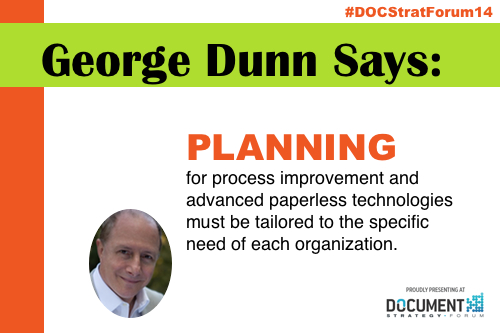
Why process innovation and paperless technology? Paperless technologies, such as scanning, capture, recognition, digital signature, electronic content management (ECM), workflow and retention/disposition, can have a powerful impact on an organization. This impact can be positive in terms of efficiency, quality and service; negative through increasing labor costs, processing time or errors; or neutral, which has the CFO asking the question: Why did we spend the money in the first place?
So how does an organization determine if paperless technologies will have a positive impact? The specific answer is not in a case study, vendor demonstration or industry white paper. The search for the exact answer starts by asking: How does the process actually work today, what are the issues in the current process, what are the requirements for change (internal and external), and exactly how will the new re-designed process function if paperless technologies are utilized?
Where do you start?
1. Research the risk, benefits and co-dependencies of paperless technology modules and overall solutions.
2. Gain an understanding of process improvement tools, methods and approaches.
3. Begin process improvement planning, evaluation and redesign well before the vendor is selected and begins installation.
4. Use the redesigned process map as a way to assess the ROI, evaluate vendor capabilities, provide direct instruction to the vendor and hold the vendor accountable. This approach is important whether selecting a new vendor for the first time or working with an existing vendor to expand an existing installation.
Over the next two months, I will share my thoughts on the current abilities of paperless technologies, how key process improvement methods such as LEAN, Six Sigma, Re-engineering and business process management can be used in planning for paperless technologies. I will also discuss how to conduct a process improvement and paperless technology project, develop a paperless technology RFP, conduct a paperless technology return on investment (ROI) assessment and select a paperless technology vendor.
As planning for process improvement and advanced paperless technologies must be tailored to the specific need of each organization, the information provided here should be treated as an introduction only and, as such, without a direct consultation of requirements, I cannot assume responsibility for the use, implementation or results information provided.
Mr. Dunn will be presenting on Tuesday, May 13, 2014 at the DOCUMENT Strategy Forum. Don't miss his Power Session P204/P205 “Taking Automation a Step Further: Process Innovation & Advanced Paperless Technology.” DOCUMENT Strategy Forum ’14 early registration ends March 6th! Register early and save up to $300. Visit www.DOCUMENTstrategyForum.com.













